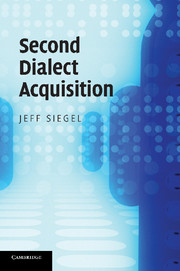Book contents
- Frontmatter
- Contents
- List of figures
- List of tables
- Acknowledgements
- List of abbreviations
- 1 Introduction
- 2 Attainment in naturalistic SDA
- 3 Acquiring a second dialect
- 4 Differential attainment: Age effects and linguistic factors
- 5 Additional individual and linguistic factors
- 6 The difficulty of SDA
- 7 SDA in classroom contexts
- 8 Educational approaches for SDA
- 9 Explaining the results and taking further steps
- Notes
- References
- Index
9 - Explaining the results and taking further steps
Published online by Cambridge University Press: 07 September 2010
- Frontmatter
- Contents
- List of figures
- List of tables
- Acknowledgements
- List of abbreviations
- 1 Introduction
- 2 Attainment in naturalistic SDA
- 3 Acquiring a second dialect
- 4 Differential attainment: Age effects and linguistic factors
- 5 Additional individual and linguistic factors
- 6 The difficulty of SDA
- 7 SDA in classroom contexts
- 8 Educational approaches for SDA
- 9 Explaining the results and taking further steps
- Notes
- References
- Index
Summary
Chapter 7 described some of the negative outcomes of both mainstream and ESL approaches in the formal education of speakers of unstandardised dialects. Chapter 8 showed little evidence of success in actual D2 acquisition in accent modification programs and the failure of SESD classroom approaches in the 1970s. However, much more positive outcomes were described for dialect coaching for performance and for instrumental, accommodation and awareness approaches in the classroom. This chapter explores some of the reasons for these results, both negative and positive. In doing so, it refers back to some of the factors that affect naturalistic SDA, as presented in Chapters 3 to 6. The chapter moves on to a discussion of further steps that can be taken to promote SDA in classroom contexts, followed by a short conclusion with some suggestions for further research.
Unsuccessful outcomes
Accent modification
As we saw in Sections 3.2 and 7.1 above, while actors can learn to produce other dialects for performance, it is much more difficult to acquire another dialect to the extent that it can be maintained in everyday use. The difference is that production for performance requires only explicit knowledge or conscious awareness of some of the features of the D2, and the ability to imitate them accurately. Actual acquisition of the D2, however, requires not only this explicit knowledge but also implicit competence, or the set of computational procedures needed to produce the D2 features automatically and consistently, as well as accurately.
Information
- Type
- Chapter
- Information
- Second Dialect Acquisition , pp. 219 - 235Publisher: Cambridge University PressPrint publication year: 2010
